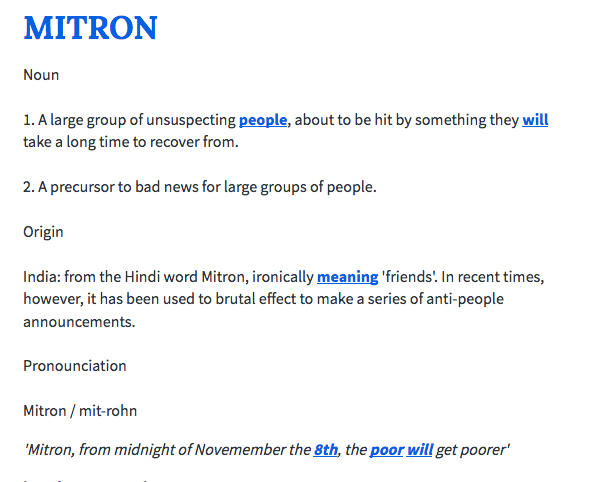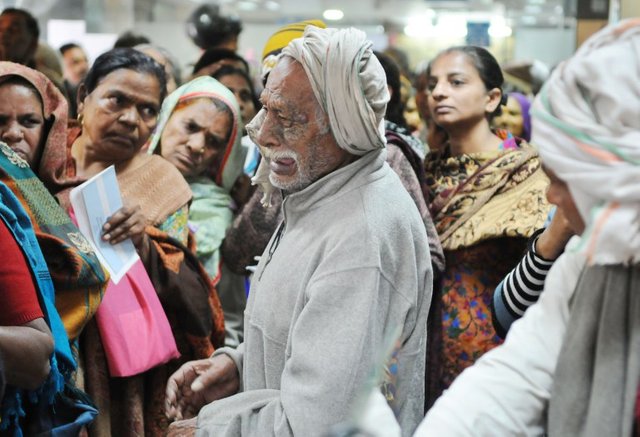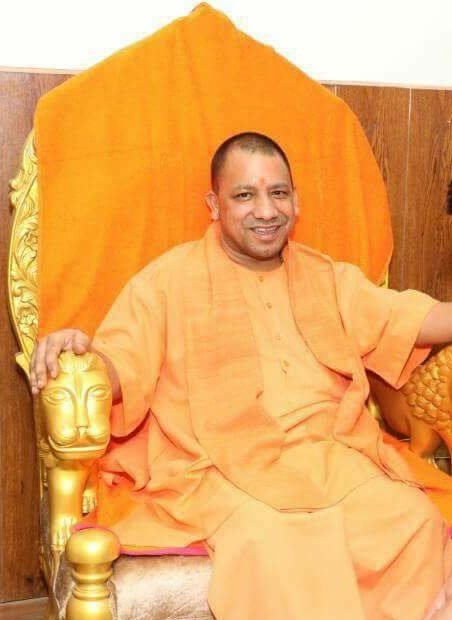Freedom and Money — the Indian Demonetization Story now 1 year old!

November 8th is the first anniversary of India's Historical move to ban 86% of its printed currency. The author does an analysis of the state of affairs in the past 365 days. It has been posted to this account as a way to protect the author from retribution.
As children we are taught that what matters more than money is freedom. Fast forward to November 8th 2017, India, in a sudden "big bang" move 86% the country's money vanished.

Figure 1: The announcement was done via a telecast that addressed the unsuspecting nation as "friends" in the national language Hindi. The word Mitron / Friends is now considered as a precursor to bad news
Chances are that you have read about the demonetization of India from Harvard Business Review, The Economist, Time Magazine etc. It's hard to imagine, but the reality of it is worse, harsher, and more unbelievable than you would likely think. "No cash," "digital revolution," "political agenda to win elections," "black money eradication program," "bold move," "monumental mismanagement," "Historical Blunder" have hit headlines, but it's hard to convey what that means to people living this way.
The author had struggled to explain the situation of "no cash" to friends and relatives not residing in the country — the most confused were those good souls who offered to send cash! For the common man, the cash, currencies became simple pieces of paper with numbers 500 and 1000 printed on them. They were just paper, and held no value any longer. Suddenly no one was able to accept currency because there ceased to be a currency.
What it looks like
In one instance the hospital rejected currency notes as they are no longer valid, in another instance the local store keeper said he will keep selling goods as long as he can without asking for money. India is a country with 1.3 Billion in population and for ease of calculation lets assume that 0.5 billion of them had some cash with them, ie we are not taking being rich or poor. We are talking about people, 500,000,000 people with pieces of paper printed by the central bank of India as legal (tender) denominations of 500 Indian Rupee, 1000 Indian Rupee etc — suddenly the value evaporated.
I had enough money to survive and so does my immediate family. But we all became helpless. We were not rich or poor any more - we just lost our freedom, we lost everything that we earned even though we still held the paper that says legal tender with us.
The reasons the media tout's this had to happen
The demonetization impacted only the super rich

(This photograph of an old man, an ex-serviceman, crying after missing his spot at a queue outside a State Bank of India branch in Gurgaon is the defining image of the demonetisation story. Credit: Praveen Kumar, Hindustan Times)
"Demonetization only impacted the rich" was one of the arguments put forth by the right wing government supporters. But when travelling miles after miles in search of ATMs with cash, there were no rich standing in the queues. There were men, women, middle class, upper middle class, daily wage laborers, migrant laborers, defense personal all were either queued up in front of the banks or ATMS.
Demonitization eradicated black money
Black money is money which is not accounted for and as per the goverment trillions of dollars worth of money, ie a minimum of 25% of the entire printed currency in the country was unaccounted for. As per RBI, the central bank of India, only 1% of the currency was not returned. Its possible that the goverment will blame Pakistan for injecting fake currency and it was a move to find the fake currency — they have not said this yet. But, if the goal was to eradicate black money that objective also failed.
Going Digital & Unique Identification Project
The next argument was the need to leap into 21st century with digital payments which is linked with Aadhar Number (which is a controversial biometric project implanted by India with complete disregard to privacy). People left with no choice used private options like PayTM which is essentially funded by Chineese funds. The PayTM founder encashed a major part of his stake during this period. In the following months, digital transactions slowly declined. Goverment launchd mobile payments initiatives like UPI which is a considerable success. UPI - Unified Payment Interface seems to have opened another can of worms. Its theoratically possible to exploit the interace via Android Operating system features and there is an increase in fraud in which numerous people are loosing money from their bank accounts linked with Aadhar Number (mandatorily and forcefully linked as expected !)
Winning by-elections

This is partly a conspiracy theory. The theory puts forward that the idea behind the currency ban without any prior notifications or planning was to win election in a key Indian state with the highest number of seats which will ensure majority for the ruling party in both the houses of the parliament. Whether the theory is true or not is unknown but the ruling party managed landslide victory in the state, secured majority in both the houses of the parliament and elected a new president with affliations to the ruling party.
The Jio factor
In Hindi "Jio" means live / live fully etc. Around the demonetization time frame Reliance - a large conglomerate with businesses varying from Petrochemicals to defense entered payment bank business with Jio Bank and they managed to attract large number of users to the platform. Jio has also launched high speed LTE based mobile services which is tightly coupled with UID / Aadhar Numbers. After the Chineese Funded PayTM the biggest benefactors are the Reliance owned Jio.
In the name of progress
Everything in India including killing people in the name of keeping / transporting cows is linked with progress and anti-corruption now. India undoubtedly has a long history and a number of achievments in the recent past as well those dating back to centuries. From 1990s when Economist and ex Central bank Governor and internationally acclaimed Dr Manmohan Singh was the brave financial minister, the country has seen tremendous growth. The author considers GDP as a mere measure rather than an actual indicator of propserity like Bhutan's Gross National Happiness (GNH) concept. Being said that India possesed a positive GDP which was much higher than most of the countries in the world except for China. The last one year period has seen phenominal dip in the GDP of the country. The author attributes part of the credit to the unscientific impmentation of demonetization.
Freedom
India is a land of contradtions, numerous cultures, chaos & can be very confusing. But beyond all the confusion, poverty, lack of equality, corruption and caste system this country always gave importance to freedom of expression & unity besides diversity. The past century, especailly the Manmohan Singh era saw people breaking the cast - religion - region boundaries and exploring opportunities. Author doesn't believe in invoking colonialism or its issues with sister countries like Pakistan or rivals like China for any of the failures. The recent decades had seen progress and increase in opportunities and freedom like never before. People who were bound to professions or regions because of economic factors also found numerous opportunities and the last 2 decades the country has started to enjoy the freedom its beautiful constitution ensures. Debate and equal opportunities were plenty & policy decisions were carefully made to protect the nation from international economic crisis. The country also had the fortune to have Prof Raghuram Rajan — an accomplished economist at the helml of policy making. But the nation is on the verge of a downward spiral. As the popular joke goes, The Indian's are forced to link everything including their underwear to Aadhar. Reasoning and debate is dead.
Economic Reality
Times are hard and as the title of the article says, the past 3 — 4 years have made the Indian people understand the value of freedom, the meaning in its true sense. Deprived of money, freedom of speech, freedom of worship, freedom of food this nation definately is in the struggle. But we will arise from the ashes once again in its true fashion.
References:
- https://hbr.org/2017/11/one-year-after-india-killed-off-cash-heres-what-other-countries-should-learn-from-it
- Fig1 : courtesy UrbanDictionary.com
- https://en.wikipedia.org/wiki/2016_Indian_banknote_demonetisation
- https://en.wikipedia.org/wiki/Uttar_Pradesh_Legislative_Assembly_election,_2017

- https://thewire.in/87680/old-man-queue-demonetisation/
- Demonetization is monumental mismanagement
Author should be praised for such brave and confronting Post. Probably there are no RSS or Right Wing members here, else this post would have been called Anti-National or Author Charged with serious Sedition Charges.
I didn't know about some facts you shared. Thanks for sharing.
Regarding the conspiracy or true success story against Black money. I totally agree with the author, the People truely affected by the Move were Middle and Lower Classes. It seemed the Corporates or Upper Classes didn't even move a muscle during Demonitization like they already knew about this move some months back and they had there things arranged accordingly.
Coming to the grievances, more than 100 people were killed as a consequence of demonitization including a girl child (as you mentioned) denied treatment by a hospital due to inavailability of right money i.e, 100 denomination notes and some elderly aged persons standing in queues for long hours. Never heard any such tragedy in Upper Class.
As you mentioned, most of the money was pooled by Some Foreign Company till they launched UPI or BHIM.
I will tell you my experience, i had been living away from family that time due to my studies and everybody knows the limited availability of cash as a student. We couldn't get groceries from the stores and travelling in public transport had become a nuisance (coz lower denomination notes were literally the gold and Everybody was keeping that close to his chest). I had i think only few 500 notes with me and depositing them back in the bank took me around 5hrs.
This purely was a stunt to stun the common and general population of India. Even though, it could have bear the fruits provided it was done with fair means not just for show off or a political stunt. The results of this stunt were clear in coming elections and even now some of them people still believe something out of it although i know many people (outside Kashmir😯) earlier Pro-Modi now are Anti.
Old currencies are usually accepted by banks and recycled by the Central banks
This is a great article. I have been curious about that and had read some materials about it.
i think it is a great move and a bold one if you ask me, great ideas are alway taunted and painted in the negative until they succeed. Cash has a way of influencing the black market so getting rid of it means big reduction in black market activities. and the printing and distibution of money is very expensive and considering a country of more than 1.2 billion people its even more expensive
But 99% of cash returned after demonetisation and cash is still the primary mode of transaction.
Really..!!I love this post👍👌
Thank you for sharing..😃😃
Demonetization did help eradicate black money in India to some extent but it had adverse effects also.
The move was sudden and people were not ready for it.
Only 5 people or so in 100 used online payment methods and rest had either no idea about or were reluctant because of security reasons.
Demonetization saw regular notes of 500 rupees and 1000 rupees vanish immediately after the announcement and now other notes are also being replaced and new ones have also been introduced like 200 rupee and 2000 rupee.
Demonetization did bring some but at what cost;
When demonetization was introduced, people had to hand over their old notes to the banks and the new ones were not being offered on exchange, instead people could only withdraw a mere 2000 rupees a day and 10000 rupees a week, that is $150 a week.
People had to stand in long queues.
I remember an incident when a pregnant woman gave birth to a child while she was standing in a queue.
Some people even died in queues.
People had to leave their work and wait for their turns just to get some money to feed their families.
Coming to "Jio", the services provided by then are awesome.
They even offered free data and calling for the first year.
Jio has revolutionised the Indian telecom industry.
The cost of their services is so cheap that almost every Indian has switched to Jio.
@minnowsupport thank you for sharing this
Nice share
This post has been ranked within the top 10 most undervalued posts in the first half of Nov 09. We estimate that this post is undervalued by $72.74 as compared to a scenario in which every voter had an equal say.
See the full rankings and details in The Daily Tribune: Nov 09 - Part I. You can also read about some of our methodology, data analysis and technical details in our initial post.
If you are the author and would prefer not to receive these comments, simply reply "Stop" to this comment.